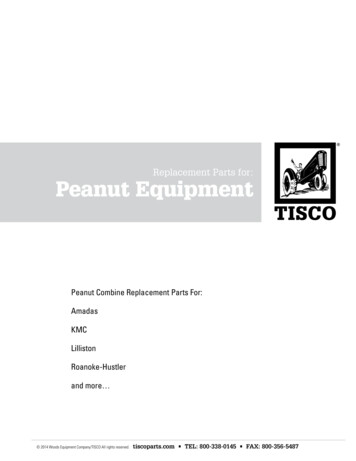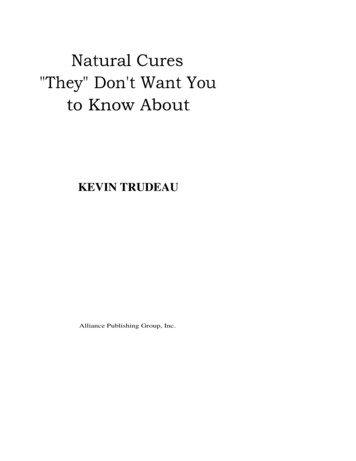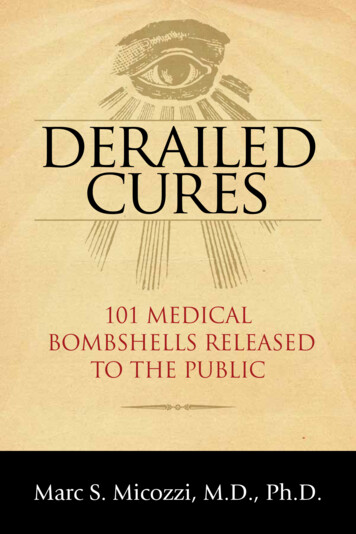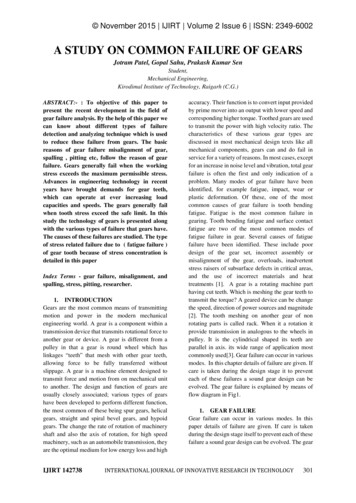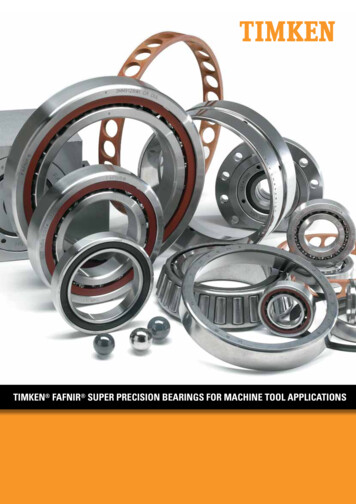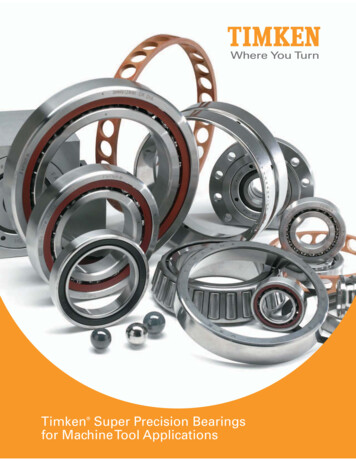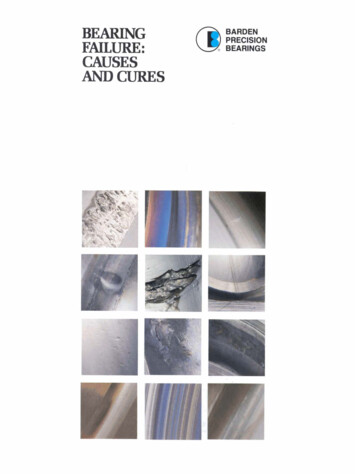
Transcription
BEARINGFAILURE:CAUSESAND CURESBARDENPRECISIONBEARINGS
aBARDENPRECISIONBEARINGSIdentitging and correcting causesof bearing faihue.Precision ball bearings are designedto have a long and useful Ii e.Assumingthe application is correct to begin with,maximizing longevity means bearings mustbe properly installed,lubricated andmaintained. Poor operating environments.oarticularlv moist or contaminated areas.ind improper handling practices invitepremature bearing- failure.When a bearing does fail,it is importantto determine the exact cause so apprcipriateadiusfments can be made. Examination ofth6 failure mode o h n reveals the truecause of failure.?his procedure is complicated by the fact that one failure mode mayinitiate another. For example, corrosion ina ball race leaves rust-an abrasive-whichcan cause wear, resulting in loss of preloador an increase in radial clearance. ?he weardebris can, in a grease-lubricated bearing,impede lubrication. resulting in lubricationfailure and subsequent overheating.?his guide will assist in properlyidentifying and analyzing 12 primary causesof bearing failure. Each characteristic isdescribed in detail and is shown in diagramform, accompanied by a color photograph.Flaws, in most cases, are readily apparent.In some cases, the imperfections maybe virtually invisible to the naked eye.Specific remedies for each situation arealso suggested.Your Authorized Barden Representativewill be happy to provide you with additionalassistance upon request
EXCESLOADi'remahL .u,u.I.area in ball path.VERHEA?isrnlnrstinlrings, ball,FALSEBRINE1-Elliptic:. .marks s teachball por;ition.LLINGBalls shwear b;Ball in lentationsin racerNays.metal fron ntactsurf?CORROSIONCONTAMINATIONDenting of hearingracewavs and balIs.r1Di[blue/brown) balltriicks and balls.MISAIRacemracewascoloratiol1ofounting su rfaces.Chemical attackresults inreddishltdiscolors
EXCESSIVEExcessive loads usually causepremature fatigue. it fits,and improper preloadingcan also ring about early timeEailure, (see T i t Fits, p. 15 andTrue &ine,p. 7). 'Ibis type of luoksthehesaraas fatigue.bavy ball wearpaths, evidence of overheatingand a more wide@spalling[fafigyearea) are u&evidentwith shortenedlife.?he selution is to reduce theload crredegignusinge bearingwith grsatsr capacity.&
OVERHEATINGBluelBlackLook for bluelblackand silv rlgolddtscolomtion BallsSymptoms are discolorationof the rings, balls, and cages fromgold to blue. Temperatures in excessof 400 F can anneal the ring andball materials. The resulting lossin hardness reduces the bearingcapacity causing early failure. Inextreme cases,balls and rings willdeform. 'Ihe temperature rise canalso degrade or destroy lubricantCommon culprits are heavyelectrical heat loads,inadequate. insufficient coolinxheat a t h sandor lubrication when loads andspeeds are excessive. Thermal oroverload controls, adequate heatpaths, and supplemental coolingare effective cures.
FALSEBRINELLINGB& path r i n a m k sFalse brinelling-ellipticalwear marks in an axial direction ateach ball position with a brightfinish and sharp demarcation, oftensurrounded by a ring of browndehris-indicates excessive externalvibration. A small relative motionbetween balls and raceway occursin non-rotating ball bearings thatare subject to external vibration.When the bearing isn't turning,anoil film cannot be formed to preventraceway wear. Wear debris oxidizesand accelerates the wear process.Correct by isolating bearingsfrom external vibration, andusing greases containing antiwearaddiGes such as molybdenumdisulfide when bearines onlvGillate or reverse rapidly & inaduator motors.FalsebrineU a k a/
TRUEBRINELLINGB d Path/\Ball SpacadCareful handlineBrinelling occurs when loadsexceed the elastic limit of the ringmaterial. BrineU marks show asindentations in the raceways whichincrease bearing vibration (noise].Severe brinell marks can causepremature fatigue failure.Any static overload or severeimpact can cause brinelling.Examples include: using hammersto remove or install bearings,dropping or striking assembledequipment, anda bearingonto a shaft by applying force tothe outer ring.Install bearings by applyingforce only to the ring being pressfitted, i.e., do not push the outer ringto force the inner ring onto a shaft.A
NORMALFrnGUEFAILURESpalled AreaModerately spalledarea indicatesreached the limitsof its useful Me.Fatigue failure-usuallyreferred to as spalling-is thefracture of the running surfacesand subsequentremoval of small.discrete particles of material.Spalling can occur on theinner ring,outer ring, or balls. Thistype of failure is progressive andonce initiated will spread as a resultof further operation. It will alwaysbe accompanied by a markedincrease in vibration,indicatingan abnormality.The remedy is to replace thebearing or consider redesigningto use a bearing having a greatercalculated fatigue life.
REVERSELQADINGaredesigned to accept an -1oadin one directionbnly.When loadedin the opposite direction,theelliptical contad area on the outer ringis truncated by fhe low shoulder onthat side of the outer ring.The msuttis excessive stress and an increasein temperature, followed byincreased vibration and earlv failure.Failure nuode is very s & i rto that of heavy i n % h n c e (tight) %.?he balls will showapovedwear band dby the ball M n govertheautdgeclgeafthe y.Corrective action is to simplyinstall the bearing w d .wntactbeadqs mustbewiththeresultant onthewideface-wbich is marked %stn-ofthe outer ring and the opposite faceof the inner ring.
hmguhdents ormaterial embeddedB d s will bedented,dull, or scratched.aid&Conhmhxdion is one of theleadinn- causes of befailure.Contamhation symptoms aredenting of the bearing raeeweysand balls resulting in high vibrationand wear.Contaminants include airbornedust, dirt or any abrasive substance that finds its way into thebearing. Principal sources are dirtytools, contaminated work areas,d i i hands and fomign matter inlubricants or cleaning solutions.Clean work areas,tools, fixturesand hands help reduce contamination failures. Keep grindingoperations away from bearingassembly areas and keep bearingsin their original packaging until youare ready to install them.Sealsare critical-damaged or inoperativeseals cannot r o t e bearinnsd
Discolored (bluelbrown)ballLUBRICANT of lubricantand balls are swptomsfailure. Eiceisive wearof balls, ring.and cages will follow,FAILUREresultina in overheatinn andtrahBalls wfll also bebluehkksubseqGent catastrophLc failure.Ball bearings depend on thecontinuous presence-of a verythin-millionths of an inch-film oflubricant between balls and races,and between the cage, bearing rings,and balls. Failures are typicallycaused by restricted lubricant flowor excessive temperatures thatdegrade the lubricant's properties.Barden engineers can adviseusers on the most suitable lubricante and quantity to use. Refer tolu ricant section of Barden C-10d o g for more information.Also,any steps taken to correct improperfit control preload better, and coolthe shafts and housings will reducebearing temperatures and improvelubricant life.9II!iii1I
CORROSIONBall pathI\or deposits ondngs.Redlbrown areas on balls, raceways, cages, or bands of ballbearings are symptoms of corrosion.This condition results fmm exposingbearings to corrosive fluids or a corrosive atmosphere. The usual resultis increased vibration followed bywear, with subsequent increasein radial clearance or loss of preload.In extreme cases. corrosion caninitiate early fatigue failures.Correct by diverting corrosivefluids away from bearing areas anduse integrally sealed bearings whenever possible. If the environmentis particularly hostile, the use ofexternal seals in addition to integralseals should be considered. ?heuse of stainless steel bearings isalso helpful.@
MISALIGNMENTMisalignmedt can be detectedshaft threads that are not squarewith shaft seats, and locking nutswith faces that are not square tothe thread axis. 'Ihe maximumallowable misalignment variesgreatlywith different applications,decreasing, for example,with speed.Appropriate corrective actionincludes: inspecting s h a h andhousings for runout of shouldersand bearing seats;use of singlepoint-turned or ground threads onnonhaedened s h a h andWide ball path onpail on onterm.1Abnormaltemperature dsesend pre-wear ofcageresults fromml4igument
LOOSEFITSOuter ring slippagecaused by improperhoo ingfits.Loose fits can cause relativemotion between mating parts. Ifthe relative motion between matingparts is slight but continuous,fretting occurs.Fretting is the generation offine metal particles which oxidize.leaving a distinctive brown color.This material is abrasive and willaggravate the looseness. If thelooseness is enough to allow considerable movement of the inner orouter ring, the mounting surfaces(bores, outer diameters, h]willwear and heat (seephoto), causingnoise and runout problems.Consult Barden C-10 catalogor Barden Engineeringforfit recommendations.
Hewpathwear indicatesti&5tTIGHTFrrsA heavy ball wear path in thebottom of the raceway around theentire circumference of the innerring and outer ring indicates atight fit.Where interference fits exceedthe radii clearance at operatingtemperature, the balls will becomeexcessivelyloaded. ?his will resultin a rapid temperature rise accompanied by high torque. Continuedoperation can lead to rapid wearand fatigue.Corrective action includes adecrease in total interferencebetter matching of bearings to shaflsand housings-taking into consideration the differences in materialsand operating temperatures.Increased radii1 clearance willalso increase bearing life underthe above conditions.
PRECISION BEARINGS Identitging and correcting causes of bearing faihue. Precision ball bearings are designed to have a long and useful Ii e. Assuming the application is correct to begin with, maximizing longevity means bearings must be properly installed
